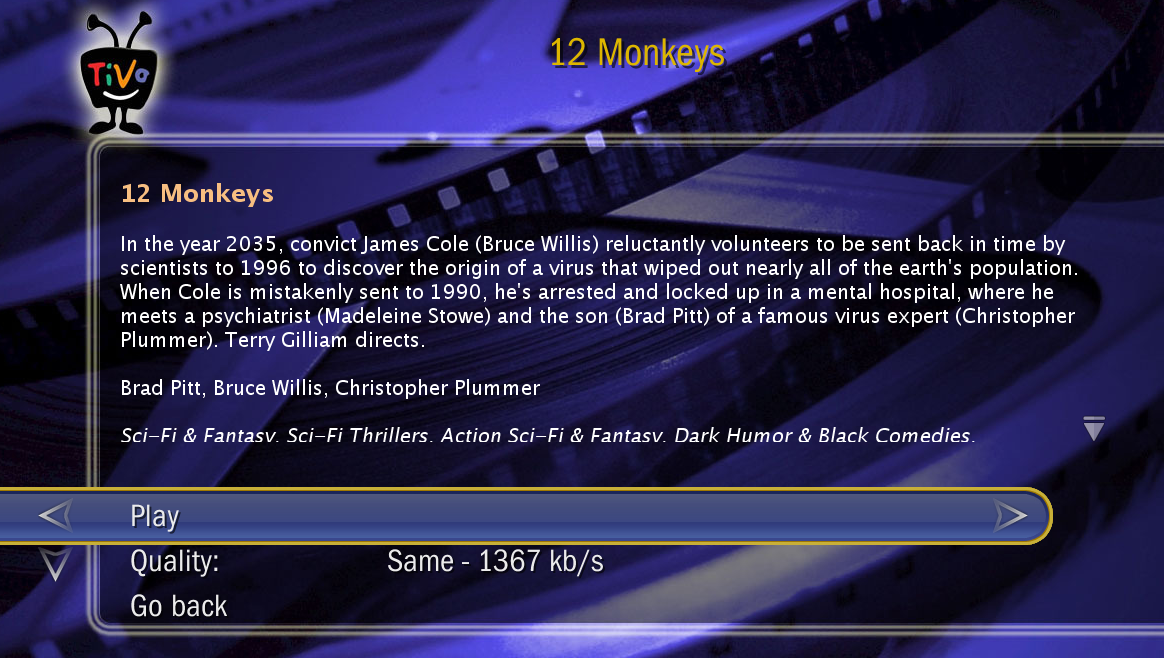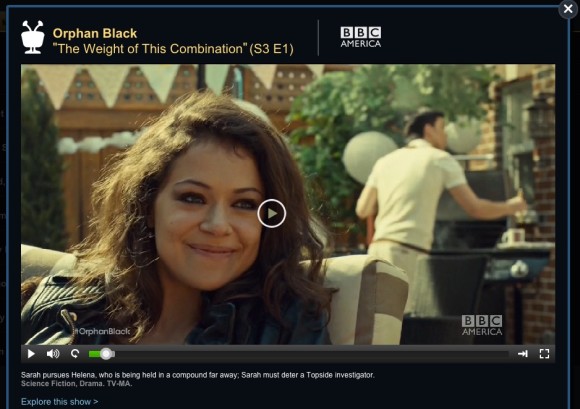It's not hard to turn your Mac or a PC into an archive for your TiVo recordings. Then you can delete the recordings from the TiVo itself, and play them from your Mac to your TiVo any time you want.
KMTTG kmttg is a Java based program to facilitate TivoToGo (TTG) transfers that can download, create pyTivo metadata, decrypt, run comskip & comcut (commercial detection and removal), create closed captions files and re-encode multiple shows. Created by Moyekj. Free Open Source; Mac; Windows; Linux.
- Kmttg was a life saver vs the the app. Better function and easier use. I have it pull videos, strip out commercials and then format the video for my tablet. I would just love to eliminate an extra computer from my setup and leverage the synology to do this.
- Download shows from, and share music, photos and videos with, your TiVo© DVR. Download for Windows Download for Mac.
I like to record classic movies from channels like TCM HD. Then I move them via my home wireless network to an external hard drive on my iMac. After that, I decode them into a non-copy-protected form that can be streamed back to a TiVo anytime I want to watch the movie again. Meanwhile, the original recording can be deleted from the TiVo's hard drive.
In Viva pyTivo!
 I detailed how I use the freeware pyTivoX app to send Mac media content to my TiVo units. Stream, Baby, Stream gave more information on the freeware StreamBaby app, which is what pyTivoX actually uses to stream media content to a TiVo. pyTivoX incorporates StreamBaby, so you don't have to install or configure StreamBaby on your Mac manually.
I detailed how I use the freeware pyTivoX app to send Mac media content to my TiVo units. Stream, Baby, Stream gave more information on the freeware StreamBaby app, which is what pyTivoX actually uses to stream media content to a TiVo. pyTivoX incorporates StreamBaby, so you don't have to install or configure StreamBaby on your Mac manually.With pyTivoX-cum-StreamBaby you can, using the TiVo itself, pull archived TiVo recordings from your Mac back to your TiVo and watch them as they stream. Streaming Mac videos to a TiVo avoids having to make copies of them on the TiVo's hard drive, so if space is limited there, streaming is the way to go.
But how do you get the original recordings from your TiVo to your Mac in the first place?
An excellent way to download TiVo files and store them on a computer is to use kmttg. kmttg, which is Java-based freeware, implements its own version of what is generally called 'TiVo To Go,' or TTG. kmttg downloads files from the TiVo and decodes them into non-copy-protected form. (It also allows you to do other neat things with the files it downloads and decodes, but I won't cover those here.) kmttg runs on several platforms, including the Mac which I use, an iMac running Mac OS X 10.5.8.
Then you'll see (click to enlarge):

What this means is that kmttg wants to download several free software tools, such as tivodecode, MEncoder, HandBrake, and FFmpeg, and to put them in appropriately named folders within the kmttg_v0p7l folder. Click 'Yes.' You'll then wait for several minutes while the downloads take place, and then you'll see (click to enlarge):
in which I configured where kmttg is to put the files it downloads or creates. In the box next to where it says TiVo Output Dir (for 'directory') I double-clicked to bring up a folder selection dialog. In it I had to navigate to find the Just Transferred folder within the TiVo Transfers folder that I set up on my external hard drive (click to enlarge):
I clicked Choose Directory once that folder was named in the File: box in the dialog. I also did the same thing for the other directories that kmttg configures via this dialog, including, crucially, the .mpg Output Dir.
In addition, I clicked check boxes to tell kmttg to Remove .TiVo after file decrypt — that meant that the downloaded TiVo file, after being decrypted into a more usable .mpg file that lacks copy protection, wouldn't permanently take up space on my Mac's external hard drive — and to Overwrite existing files in situations where I reinitiate jobs that have failed to run to completion previously.
At this point I clicked 'OK,' and kmttg was configured the way I wanted it.
- selecting the Living Room TiVo tab and clicking the Refresh button
- selecting 'The Gallant Hours' from the Now Playing list that appeared after several seconds
- clicking the START JOBS button
title : The Gallant HoursseriesTitle : The Gallant Hoursdescription : Adm. William F. 'Bull' Halsey Jr. outwits Japanese Adm. Yamamoto in the 1942 Pacific.time : 2010-04-30T06:15:00ZmpaaRating : N8movieYear : 1960isEpisode : falseisEpisodic : falseshowingBits : 1024starRating : x6displayMajorNumber : 890callsign : TCMHDvActor : Cagney|JamesvActor : Weaver|DennisvActor : Costello|WardvActor : Jaeckel|RichardvActor : Tremayne|LesvActor : Burton|RobertvActor : Bailey|RaymondvActor : Reid|Carl BentonvActor : Sande|WaltervActor : Swenson|KarlvActor : Landers|HarryvActor : Carlyle|RichardvActor : Lontoc|LeonvActor : Yagi|JamesvActor : Zaremba|JohnvDirector : Montgomery|RobertvProducer : Montgomery|RobertvProgramGenre : BiographyvSeriesGenre : BiographyvSeriesGenre : DocumentaryvSeriesGenre : Movies
Now, in the following screen shot (click to enlarge), the 'decrypt' job has finally begun executing:
The 'decrypt' job invokes an app, tivodecode, that decrypts the The Gallant Hours (04_30_2010).TiVo file that was just downloaded, making a file named The Gallant Hours (04_30_2010).mpg in the same directory. This .mpg file contains the entire original recording at the original bitrate, file size, and quality. The only difference is that it is unencrypted. StreamBaby can accordingly stream it back to a TiVo.
kmttg offers a wide range of functionality beyond what I've just described, but this should be enough to get you started. You now know how to get kmttg, install it on your Mac, and begin using to to download, decrypt, and save metadata from recordings on your TiVo. These can be high-definition or standard-definition recordings — your choice. I generally download HD ... but be warned: HD takes a lot more time to download and a lot more space on your Mac's hard drives.
And HD is just about impossible to stream back, without a lot of undesirable pauses, to any TiVo model other than the new TiVo Premiere. Only the Premiere can do network input/output fast enough to keep up with pause-free HD streaming. Older TiVo models simply cannot do this — I know, I have three of them. To get a Premiere to stream HD video in 'real time,' you'll also need to equip it with a wireless-N adapter, or hook it up to wired Ethernet, since anything slower is too slow for real-time HD streaming.
It is possible, though, to use the PyTivo part of PyTivoX to transfer archived HD (or SD) recordings back to a non-Premiere TiVo's Now Playing List (i.e., to the TiVo's own hard drive). You'll just have to initiate the transfer some time in advance of when you want to watch the recording. If you allow sufficient lead time, you'll be able to watch the program, pause-free, even while the transfer is still ongoing.
But for pause-free spur-of-the-moment streaming of HD material that you have archived to your Mac, consider getting a TiVo Premiere with a wireless-N adapter. I personally love my own Premiere/wireless-N setup for just that reason.
Contents |
Based on this guide.
Discussion for this wiki can be found here
This tutorial uses exclusively open source software although kmttg has alternatives to use some commercial software. It takes a while to go through this tutorial, but it is well worth it at the end.
kmttg is a Java based program I (not me the author of this tutorial, a cool developer named Kevin Moye) wrote to facilitate Tivo To Go (TTG) transfer's that can download, create pyTivo metadata, decrypt, run comskip & comcut (commercial detection and removal), create closed captions files and re-encode multiple shows you select from your Tivos all automatically. The program also has the capability to transfer and process shows automatically from your Tivos based on titles and keywords you setup.
You can select one or more shows at a time and then with one click of a button the program will download all the selected items, with the options of also automatically creating a metadata file for pyTivo, decrypting, TiVo files to .mpg, running comskip (commercial detection and removal program), and automatically re-encoding to a more portable format using mencoder, ffmpeg or any other command line encoder of your choosing. The program queues up multiple jobs and displays time, size and speed statistics for ongoing jobs.
Previously I was using different point tools to accomplish this, such as Tivo Desktop or TivoPlayList for downloads, pyTivoMetaGen for generating metadata files, Tivo Decoder UI for decrypting and various GUIs built around ffmpeg for re-encoding. I did not want to pay for or be limited by Tivo Desktop Plus. This is my attempt to simplify and automate these different tasks all into 1 simple GUI.
1. Install OpenJDK version of Java.
2. Download kmttg installation zip file from here.
- Obtain version v0p8l or later.
3. Install ProjectX video repair.
Although ProjectX exists in Ubuntu repositories, I do not recommend that particular outdated version. Instead, download a ProjectX_0.91.0.zip file from here and place it in /home/$USERNAME/kmttg. Afterwards, unzip downloaded file and create a link:
4. Download and build tivodecode.
5. Download comskip and wine and configure comskip to run via wine.
- While comskip is open source software, folks haven't quite figured out how to build it on Linux due to a number of complexities. So, we will use a windows build instead and use wine to execute it. Don't worry, it will all be under the covers.
6. Download HandBrake encoder.
7. Download Atomic Parsley metadata processor.
- You must know your 10 digit Media Access Key (MAK) for your TIVO. PLEASE do not post your MAK in these forums!
From http://support.tivo.com/app/answers/detail/a_id/196, question 'Unable to transfer video from TiVo DVR to PC'
NOTE: You can find your Media Access Key in either of these two places:
From your TiVo DVR: Go to TiVo Central, select Messages & Settings, then Account & System Information, and then Media Access Key.
Online: Log in to your My TiVo account.

Kmttg Copy Protected
When I say $USERNAME, I mean your actual username.
Pytivo Download
- Run kmttg by typing ~/kmttg/kmttg
- Enter your MAK
- Configure your software by selecting File/Configure and selecting Programs tab
- Check that kmttg auto-detected your handbrake at /usr/bin/HandBrakeCLI
- Check that kmttg auto-detected your tivodecode at /home/$USERNAME/tivodecode/tivodecode
- Check that kmttg auto-detected your comskip at /home/$USERNAME/kmttg/comskip/comskip
- Check that kmttg auto-detected your ProjectX as /home/$USERNAME/kmttg/ProjectX/ProjectX.jar
- Click Refresh for kmttg to update list of your TIVO programs
- Select checkboxes ☑ metadata ☑ decrypt ☑ QS Fix ☑ Ad Detect ☑ Ad Cut ☑ encode
Select Encoding Profile: hb_television
Select your favorite programs and click [START JOBS] on the top left.
- Wait, and then enjoy your videos on your computer or your mobile device.
Note that encoding profile hb_television is a good place to start but is not a perfect profile. There is truly no perfect encoding profile, so use HandBrake GUI to optimize your encoding experience. A file encoded using hb_television profile won't play on your Android phone or tablet (you would not use a closed source tablet, would you?), so use ff_droid or hb_iphone preset instead for taking your TIVO shows on the road.
Originally posted The Ubuntu Forums (ubuntuforums.org)